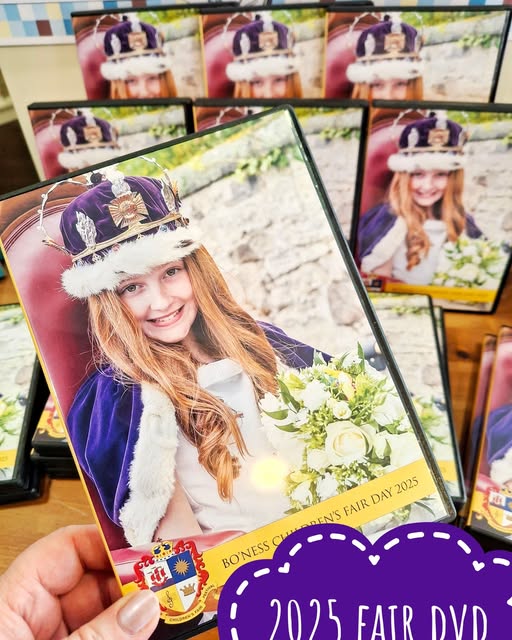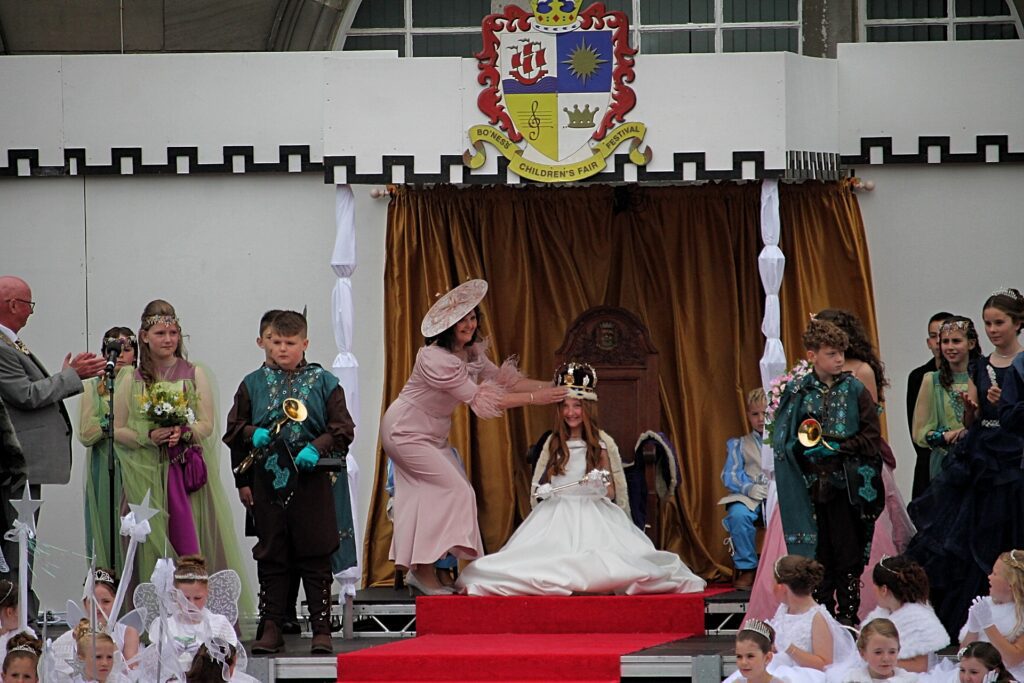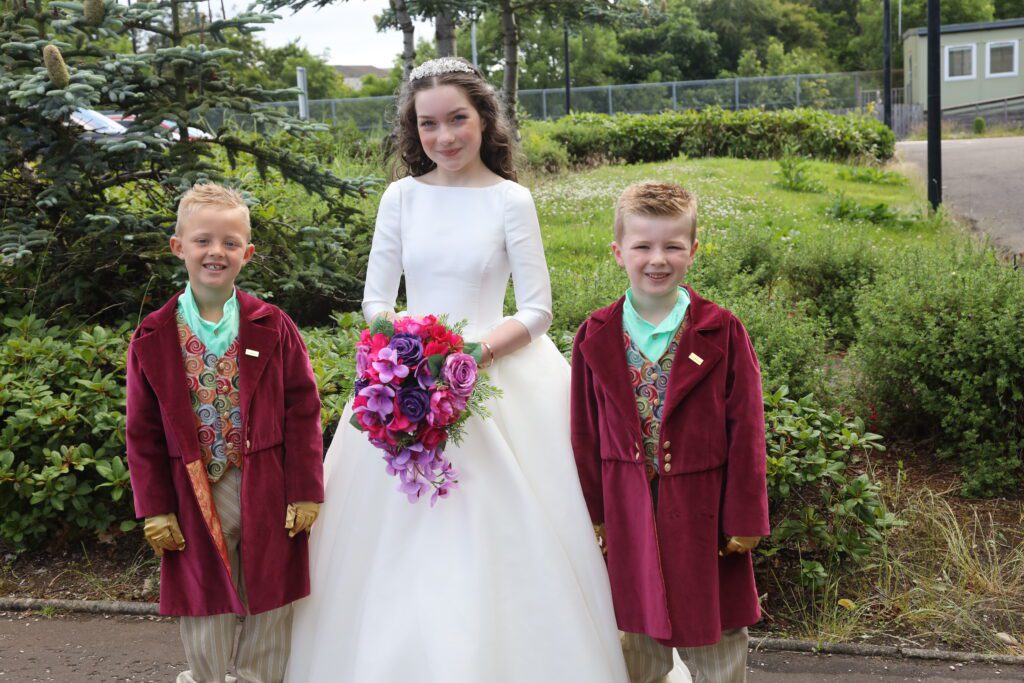“The morn’s the Fair and I’ll be there and I’ll hae up my curlie hair.”
So chanted the wee lasses of the Public, Grange and Kinneil schools as they dashed excitedly home down the School Brae, Castleloan Brae and Cowdenhill Brae on past Fair E’ens and to many Bo’nessians the Fair is still very much something, which happens all of a rush at the end of June. To true “Fair Hands”, however, the Fair is an all the year round preoccupation, for just as with the miners who started it all almost 200 years ago, as soon as one Fair is over their thoughts turn to the following summer’s big day.
For some of these Fair enthusiasts this means a summons to the first planning session of the Fair Executive Committee before the youngsters have even returned to the school after the summer holidays. For others it is just an idea at the back of their minds, which come the light nights will blossom into a colourful tableau or the most spectacular arch ever seen.
The Fair is now so much a part of the traditions of Bo’ness that there are, of course, some parts of it which appear just happen. There is no need for instance to tell the schools when it is their year to choose the Queen and all of her impressive retinue. Long before their bairns go to school for the first time most proud mothers can tell you if their daughters will be lucky enough to be in ” the Queen’s class” and while fathers for years beforehand may protest at the costs which they face, when the voting finally takes place and their Jane or Linda or Margo is chosen to be a lady in waiting, or even the Queen herself, money seems to matter little for the delight which it brings.
If the Fair is to live up to the children’s expectations, however, there is a tremendous amount of background detail, which must be carefully attended to and following the public annual general meeting in the late autumn the many committees set to work.
First the date for the Fair must be agreed. Traditionally the Fair should be on the “first Friday after the second Tuesday in July”, but changes in the pattern of school holidays have dictated a move away from the time-honoured Glasgow Fair Friday to one in late June or early July.
Immediately the day is settled bands must be booked. It is not so much a question of choosing bands as negotiating with them for demands for their services at the height of the summer season are many and varied and they can well afford to pick and choose their engagements and while the appearance of our own top class Carriden, Kinneil and Salvation Army Bands and young Kinneil Pipe Band is always guaranteed, it is still necessary to find another six to make up the complement of ten.
With so many brass band experts and enthusiasts in Bo’ness the standard of the visiting bands must be high in order to match that that of our own talented musicians and therefore, the search always takes in all available military bands. The desire to present the white pith helmeted Band of the Royal Marines or the black bear skinned Band of the Scots Guards is, however, fraught with dangers for, as top fighting men as well as top musicians, there is always the chance that they may be ordered overseas to some new trouble spot at the very last minute, as happened last year, leaving a gap in the procession, which must be filled.
Having booked the necessary ten bands is, however, by no means the end of the Fair Committee’s worries, because they then have to be paid for and as a grade one band can now cost well over £200 for the day, it is good to know that the Informal Entertainments Committee and the Appeals Committee are both already hard at work. While the Appeals Committee concentrates on giving every Bo’nessian the opportunity to contribute through the annual door to door collection and through participation in the prize draw., the Informal Entertainments Committee gives them regular chances to boost Fair funds while at the same time enjoying themselves at functions ranging from high fashion mannequin parades to ladies’ football matches and from highly skilled clay pigeon shoots to fun-filled gird races through the streets of the town.
No matter how the money is raised, however, it is desperately needed for, like everything else, running an event the size of Bo’ness Fair, which can truly boast of being one of the largest children’s days in the whole of Britain, costs more and more each year. While the time-honoured shilling for every one of the almost 2,000 children in the big parade has been abandoned, Bo’ness Fair still provides every child with the equally traditional Fair Bag, instead of charging parents for it as is done at most other gala days in the area. In addition the Catering Committee has also to ensure that lunches are provided for all of the bandsmen and drivers of decorated vehicles and for the young “Queen” and leading members of her young retinue. The set meal for these children in the auditorium in contrast to the picnic enjoyed by their friends in the Douglas Park, is not simply to maintain the regal tone of the occasion, but to ensure that they enjoy an hour away from the public gaze on what is a very long and demanding day.
Most years the Catering Committee has also to provide for even more children than those from the Bo’ness schools, for the custom of inviting young entertainers from overseas, ranging from dancers from Poland to singers from Czechoslovakia, is fast becoming a tradition which is giving a new and wider appeal to the Fair at very little cost, for these talented young foreigners from as far away as the United States and the Pacific Coast of Canada, receive small fees compared with other bands.
While these young people from abroad add fresh international attractions to the Fair programme, it is, however, undoubtedly our own Bo’ness bairns who will always sustain the main part of the Fair Festival and by March each year it is time for the pupils of the Queen’s school to take part in the secret ballot which elects the young monarch. From then on there is plenty of work for fathers designing arches, for mothers choosing materials and planning outfits, for local dressmakers making everything from fairy dresses to monster costumes and for headmasters and teachers training the children for their varied roles. For while the Queen’s school has the main task of turning 60 lively little individuals into the highly disciplined precision trained royal retinue, which earns such praise from visitors to Bo’ness on the big day, the other schools are also busy devising often highly complicated routines for their colourful presentees who this year will range from Olympic athletes to the townsfolk and rats of the famous story of the Pied Piper.
As the children practise and rehearse, so too do the adults behind the scenes make their preparations. Can an articulated vehicle swing from the Wynd onto Panbrae Road, how wide is South Street outside the Co-op, will a 20-foot high windmill clear all overheard telephone lines? These are only a few of the hundred and one problems which the members of the procession committee have to solve even after they have persuaded the full committee to accept the often vexed question of the exact route. To them also falls the difficult task of allocating places to schools on the limited number of decorated vehicles, for there is nothing so annoying to a mother as to see her eight-year-old walking while nine-year-olds from another school wave down from a passing float
The mile-long grand procession does in fact call for a great deal of adult supervision and while there was a welcome increase in parents acting as stewards at last year’s Fair many more are still required for amid all the glitter and glamour safety must always come first. This also applies equally well in the Glebe Park at the Coronation Ceremony in the morning and in the Douglas Park for the Royal Revels in the afternoon where, from the very outset, the members of the Parks Committee face the tremendous physical task of unloading hundreds of children from the floats and tableau.
The appeal, therefore, is for many more adults to give up two or three hours on the Fair Day to make certain that all of the town’s boys and girls have as enjoyable a time as the Executive Committee has carefully planned for them. For by the Fair E’en many hours of detailed planning has gone into the Fair from working with the police to dovetail crowd and traffic control to checking insurance policies for everything from damage to floats to a wet day, and from time-tabling the bands to making sure that you’ve had a chance to buy this magazine.
And having read this article you may ask whether the Fair is worth so much time and energy from adults and children. You alone can answer that question as the hands of the big Town Hall Clock sweep up to 11 o’clock and young Queen Margo is crowned 67th Queen of Bo’ness Fair. For true Bo’nessians, many of them come home for the big day from as near as Grangemouth and Bathgate and from as far as Australia and Canada, there can, however, be no doubt as to the answer as they listen to the massed choir of school children sing “Our Festal Day” and “Hail to Our Queen”.
It is to be hoped that, in these days of commercialisation, regionalisation and all the other impersonalisations, there will always be sufficient devoted Bo’ness to make certain that there is still this “Midsummer Holiday Festival” for them to come home to and for all our children to enjoy and someday recall when it is the turn of their offspring to “raise their voices with a cheer” and sing “Hurrah for Our Queen”.
UNKNOWN






